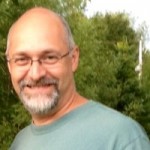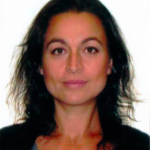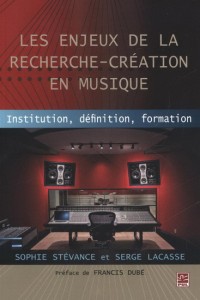The music and multimedia research-creation laboratory at Université Laval
On December 4th, 2015 I interviewed Sophie Stévance (Professor and Canada Research Chair in Research-Creation in Music) and Serge Lacasse (Professor in musicology) about their work with the CFI and OIF funded LARCEM (Laboratory for research-creation in music and multimedia) based at University Laval in Quebec City.
I was interested in finding out more about their process as researchers working collaboratively in a creative laboratory space. Having read some of their recent publications including Research-Creation in Music as a Collaborative Space and Les Enjeux de la recherche-creation en musique I was curious how they viewed the importance of the space in which they conducted their research.
The following is a summary of our Skype conversation. I have not transcribed my recording word for word in the interest of being concise. I sent some questions in advance and we began our conversation here.
I asked: How does the LARC studio space affect your research-creation projects? What are the specific aspects of the space that influence what goes on inside and what is produced there? Was the space designed collaboratively to enable research-creation projects?
The LARC was designed to be a recording studio of the highest quality that would be suitable for collaborative research-creation projects. It features a large central space for musicians, a main control room, as well as 3 smaller control rooms which can all be linked. This allows people to work individually or together on various projects. The space has excellent acoustics which has a huge impact on the musicians’ experience and the quality of their work. Lacasse described one violist who exclaimed after playing in LARC that “It’s the first time I feel like I’m playing music!” Not surprisingly the researchers who are now using the space were heavily involved in the design process. Stévance and Lacasse describe a smooth process working with acoustic architect and designer Martin Pilchner, although they had to explain many of the specific requirements of their space to the university’s facility services (service des immeubles) since it was an unconventional building project. There’s no doubt that having a state of the art facility affects the quality of the work accomplished but it also enables the researchers to invite high profile performers to collaborate and use the space. In discussing collaborative projects our conversation shifted toward what happens within the “microcosm” of the recording studio.
The LARC is mainly a recording studio but it is also a research space. Stévance and Lacasse emphasize that each project is unique and driven by those involved in the collaboration. Musicians don’t magically become researchers because they’ve entered into a space where research is also happening. Research-creation happens when there is a reciprocal and symbiotic relationship between the collaborators. The infrastructure they’ve established allows them to work directly with musicians and researchers to create in real time while simultaneously studying the process that unfolds. The skills, abilities and talents of each collaborator informs what happens in the studio. Lacasse works as a musicologist, a researcher, and a musician but not at the same time. The process is very spontaneous but is closely examined as well.
Stévance and Lacasse offered an example of a collaboration undertaken with Inuit artist Tanya Tagaq. Stévance had been studying the work of Tagaq since 2007 and invited her to record some of her 2013 album Animism at LARC. Stévance was able to study Tagaq’s creative process in person, as it developed in the studio. Lacasse was also participating in the project, he got involved with the sound mixing and later contributed some percussion work to the recording session. When Tagaq observed Stévance’s notations (which mapped Tagaq’s improvisational process) the singer became interested in the musicological research and this analysis in turn informed her vocal performance. Stévance and Lacasse offer a more detailed account of this work with Tagaq in their publications, but this example demonstrates how participants change roles and how what emerges from a collaboration cannot be anticipated beforehand. Tagaq will return to the LARC to work on her 4th studio album in January 2016 and she will also be performing at the Palais Montcalm on February 18th. This live show will further inform Stévance’s research into Tagaq’s performative choices including how her bodily movements relate to her vocals in a live concert setting.
Given the spontaneous, emergent, participant-driven nature of their research-creation work, I asked my interviewees if they had specific strategies for acquiring funding. They expressed that this was an area of concern particularly because of the unique nature of research-creation as being not just research or creation. Research-creation committees at SSHRC and especially FRQSC, for example, have adjudicators that are accustomed to evaluating the artistic merit of a project, and they may not value the research contributions at all. Lacasse gave me an example of applying for an FRQSC grant and being told to remove the research portion of his application, which he did in order to get the research-creation grant.
This interview helped me think through the similarities between a media lab and the recording studio. Both are heterotopic spaces that have a mysterious quality in terms of what goes on inside. Laborious creative processes occur, often collaboratively, and research reflecting on these processes is produced. Media labs are heterogeneous spaces that can shift and evolve over time. Cutting-edge technologies inform the work being done and funding increases the chances of having tools that improve the quality of what the lab produces, as well as the calibre of researchers and guests invited to work within the space. Branding a workspace as a media lab creates an identity with the potential to bring people together to birth ideas, build prototypes, access funding, and produce research (often collaboratively). Sophie Stévance and Serge Lacasse have clearly defined their process as research-creation and they use this term effectively to describe to their unique research practice and the spaces in which their collaborations transpire.




